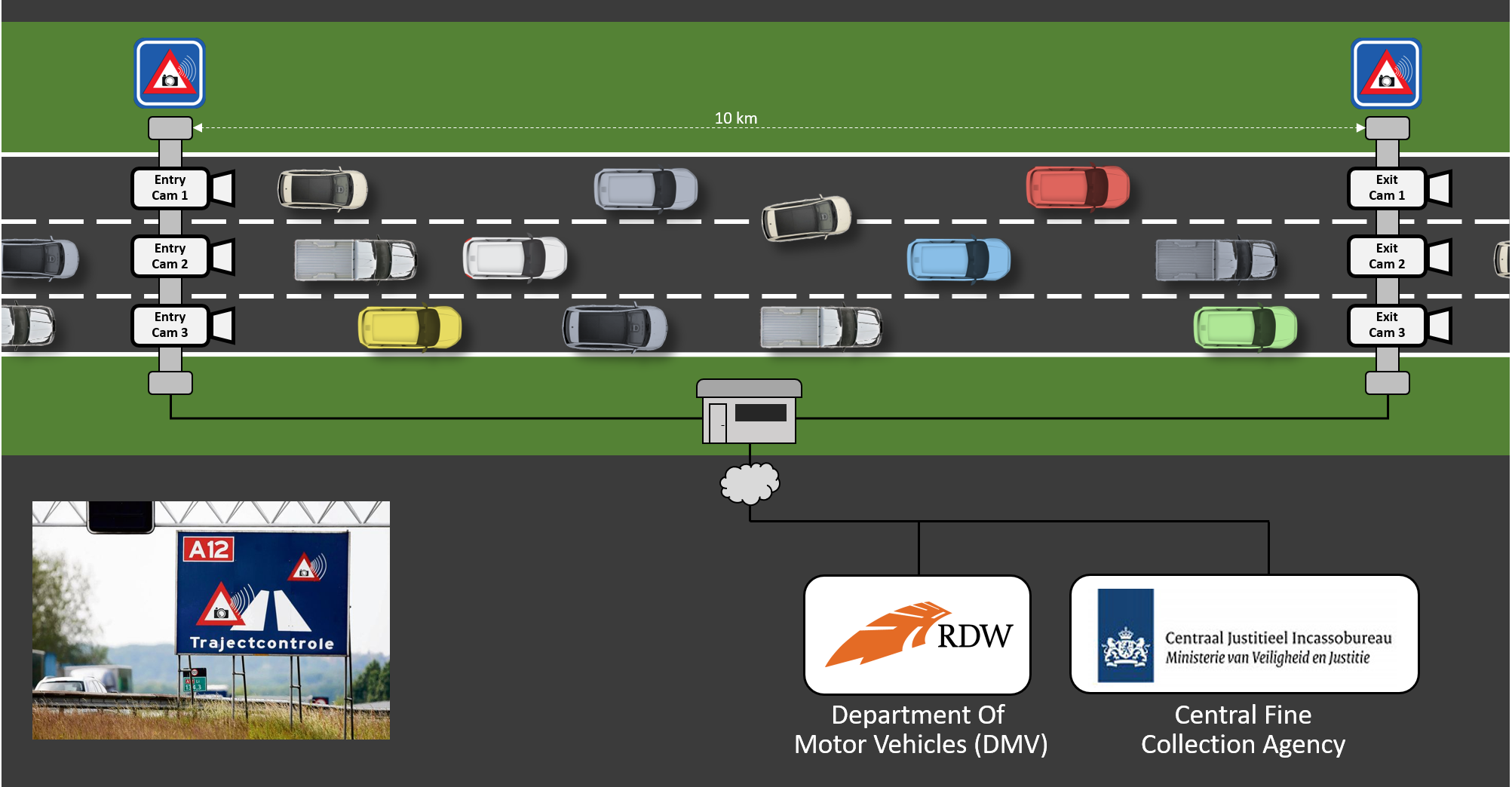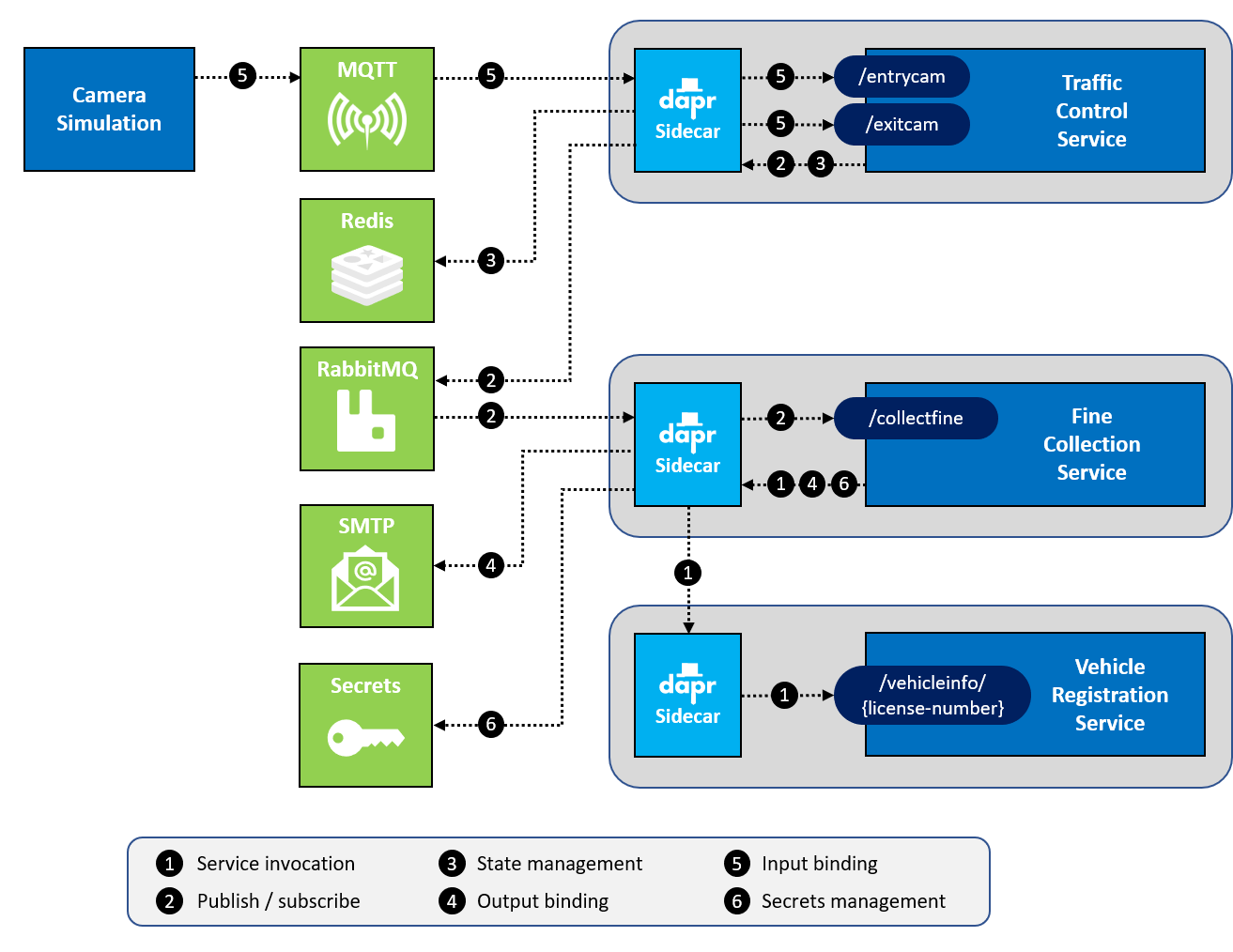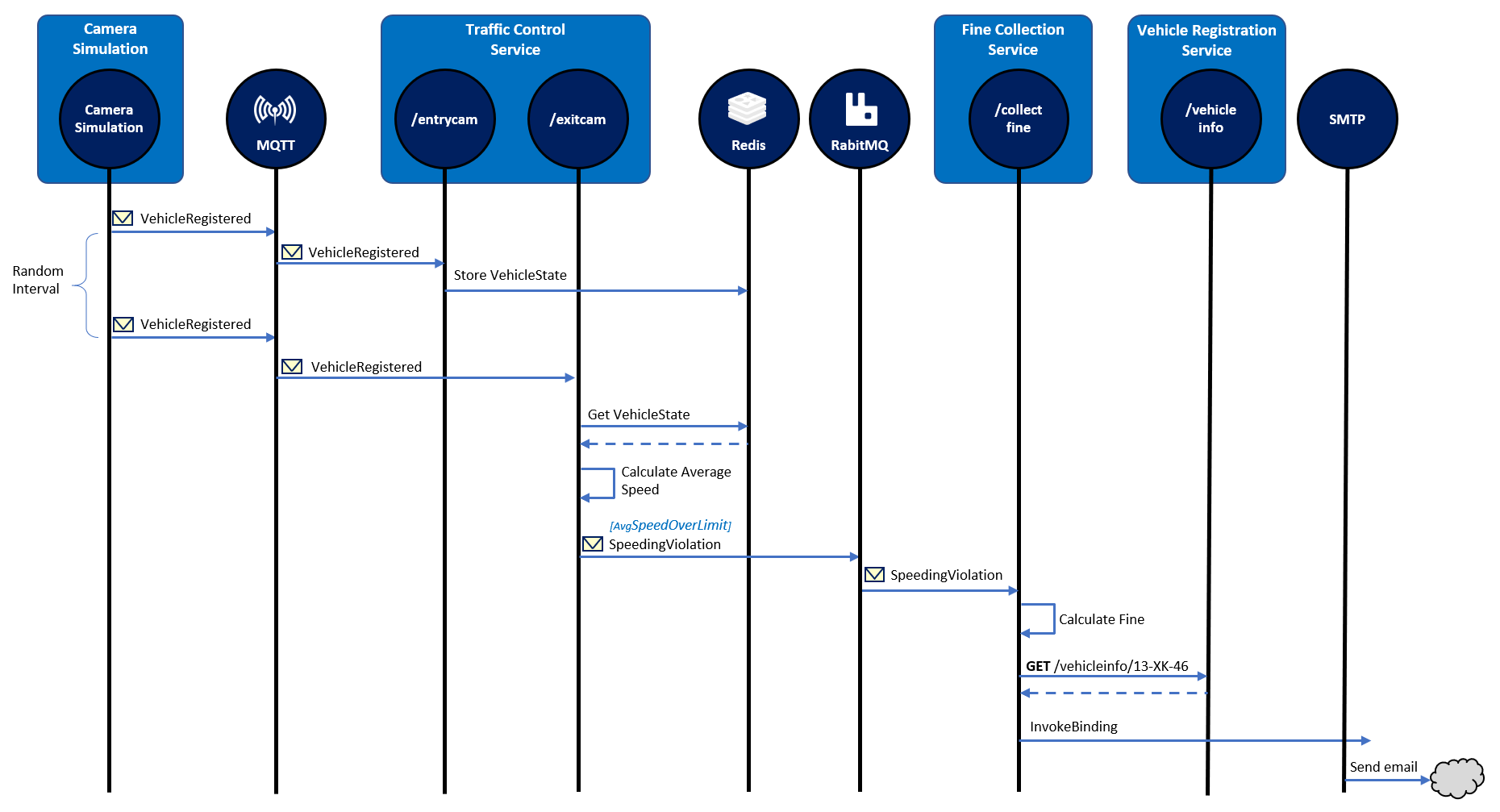This repository contains several hands-on assignments that will introduce you to Dapr. You will start with a simple ASP.NET Core application that contains a number of services. In each assignment, you will change a part of the application so it works with Dapr (or "rub some Dapr on it" as Donovan Brown would say). The Dapr building blocks you will be working with are:
- Service invocation
- State-management
- Publish / Subscribe
- Bindings
- Secrets management
You will be using Dapr in self-hosted mode.
For the assignments you will be working with a speeding-camera setup as can be found on several Dutch highways. This is an overview of the fictitious setup you're simulating:
There's 1 entry-camera and 1 exit-camera per lane. When a car passes an entry-camera, the license-number of the car and the timestamp is registered.
When the car passes an exit-camera, this timestamp is also registered by the system. The system then calculates the average speed of the car based on the entry- and exit-timestamp. If a speeding violation is detected, a message is sent to the Central Fine Collection Agency (or CJIB in Dutch). They will retrieve the information of the owner of the vehicle and send him or her a fine.
In order to simulate this in code, the following services are defined:
The src folder in the repo contains the starting-point for the workshop. It contains a version of the services that use plain HTTP communication and store state in memory. With each assignment of the workshop, you will add a Dapr building block to the solution.
- The Camera Simulation is a .NET Core console application that will simulate passing cars.
- The Traffic Control Service is an ASP.NET Core WebAPI application that offers 2 endpoints:
/entrycamand/exitcam. - The Fine Collection Service is an ASP.NET Core WebAPI application that offers 1 endpoint:
/collectfinefor collecting fines. - The Vehicle Registration Service is an ASP.NET Core WebAPI application that offers 1 endpoint:
/getvehicleinfo/{license-number}for getting the vehicle- and owner-information of a vehicle.
The way the simulation works is depicted in the sequence diagram below:
- The Camera Simulation generates a random license-number and sends a VehicleRegistered message (containing this license-number, a random entry-lane (1-3) and the timestamp) to the
/entrycamendpoint of the TrafficControlService. - The TrafficControlService stores the VehicleState (license-number and entry-timestamp).
- After some random interval, the Camera Simulation sends a VehicleRegistered message to the
/exitcamendpoint of the TrafficControlService (containing the license-number generated in step 1, a random exit-lane (1-3) and the exit timestamp). - The TrafficControlService retrieves the VehicleState that was stored at vehicle entry.
- The TrafficControlService calculates the average speed of the vehicle using the entry- and exit-timestamp. It also stores the VehicleState with the exit timestamp for audit purposes, but this is left out of the sequence diagram for clarity.
- If the average speed is above the speed-limit, the TrafficControlService calls the
/collectfineendpoint of the FineCollectionService. The request payload will be a SpeedingViolation containing the license-number of the vehicle, the identifier of the road, the speeding-violation in KMh and the timestamp of the violation. - The FineCollectionService calculates the fine for the speeding-violation.
- The FineCollectionSerivice calls the
/vehicleinfo/{license-number}endpoint of the VehicleRegistrationService with the license-number of the speeding vehicle to retrieve its vehicle- and owner-information. - The FineCollectionService sends a fine to the owner of the vehicle by email.
All actions described in this sequence are logged to the console during execution so you can follow the flow.
After completing all the assignments, the architecture has been changed to work with Dapr and should look like this:
- For doing request/response type communication between the FineCollectionService and the VehicleRegistrationService, the service invocation building block is used.
- For sending speeding violations to the FineCollectionService, the publish and subscribe building block is used. RabbitMQ is used as message broker.
- For storing the state of a vehicle, the state management building block is used. Redis is used as state store.
- Fines are sent to the owner of a speeding vehicle by email. For sending the email, the Dapr SMTP output binding is used.
- The Dapr input binding for MQTT is used to send simulated car info to the TrafficControlService. Mosquitto is used as MQTT broker.
- The FineCollectionService needs credentials for connecting to the smtp server and a license key for a fine calculator component. It uses the secrets management building block with the local file component to get the credentials and the license key.
The sequence diagram below shows how the solution will work with Dapr:
If during the workshop you are lost on what the end result of an assignment should be, come back to this README to see the end result.
Make sure you have the following prerequisites installed on your machine:
- Git (download)
- .NET 5 SDK (download)
- Visual Studio Code (download) with at least the following extensions installed:
- Docker for desktop (download)
- Install the Dapr CLI and initialize Dapr locally
All scripts in the instructions are Powershell scripts. If you're working on a Mac, it is recommended to install Powershell for Mac:
- Powershell for Mac (instructions)
The workshop has been tested with the following versions:
| Attribute | Details |
|---|---|
| Dapr runtime version | v1.1.1 |
| Dapr.NET SDK version | v1.1.0 |
| Dapr CLI version | v1.1.0 |
| Platform | .NET 5 |
Every assignment is contained in a separate folder in this repo. Each folder contains the description of the assignment that you can follow.
It is important you work through all the assignments in order and don't skip any assignments. The instructions for each assignment rely on the fact that you have finished the previous assignments successfully.
The src folder in the repo contains the starting-point for the workshop. It contains a version of the services that use plain HTTP communication and stores state in memory. With each assignment of the workshop, you will add a Dapr building block to this solution.
Every description of an assignment (accept the first one) contains two parts with each a certain approach to executing the assignment: a DIY part and a step-by-step part. The DIY part just states the outcome you need to achieve and no further instructions. It's entirely up to you to achieve the goals with the help of the Dapr documentation. The step-by-step part describes exactly what you need to change in the application step-by-step. It's up to you to pick an approach. If you pick the DIY approach and get stuck, you can always go to the step-by-step approach for some help.
During the workshop, you should be working in 1 instance of VS Code. You will use the integrated terminal in VS Code extensively. All terminal commands have been tested on a Windows machine with the integrated Powershell terminal in VS Code. If you have any issues with the commands on Linux or Mac, please create an issue or a PR to add the appropriate command.
During the workshop you will run the services in the solution on your local machine. To prevent port-collisions, all services listen on a different HTTP port. When running the services with Dapr, you need additional ports voor HTTP and gRPC communication with the sidecars. By default these ports are 3500 and 50001. But to prevent confusion, you'll use totally different port numbers in the assignments. If you follow the instructions, the services will use the following ports for their Dapr sidecars to prevent port collisions:
| Service | Application Port | Dapr sidecar HTTP port | Dapr sidecar gRPC port |
|---|---|---|---|
| TrafficControlService | 6000 | 3600 | 60000 |
| FineCollectionService | 6001 | 3601 | 60001 |
| VehicleRegistrationService | 6002 | 3602 | 60002 |
If you're doing the DIY approach, make sure you use the ports specified in the table above.
The ports can be specified on the command-line when starting a service with the Dapr CLI. The following command-line flags can be used:
--app-port--dapr-http-port--dapr-grpc-port
Now it's time for you to get your hands dirty and start with the first assignment:
-
Clone the Github repository to a local folder on your machine:
git clone https://github.com/EdwinVW/dapr-workshop.git -
Before starting with the assignments, I suggest you check-out the code of the different services. You can open the
srcfolder in this repo in VS Code. All folders used in the assignments are specified relative to the root of the folder where you have cloned the dapr-workshop repository. -
Go to assignment 1.




